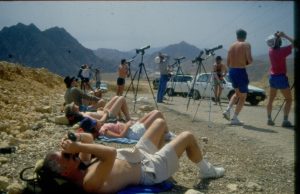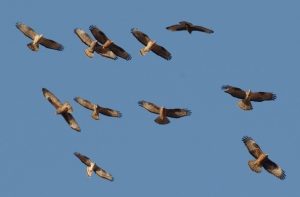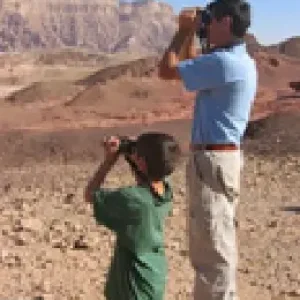From Africa, they make their way to Europe and Asia. Hundreds of millions of birds pass through this natural gateway. Tired and hungry, they stop briefly in Eilat before continuing their arduous journey to the place where they will build new families. Eilat is like a busy train station where, for a fleeting moment, a Steppe Buzzard from Asia meets a Honey Buzzard from Europe, or a Siberian Chiffchaff crosses paths with its Western European relative. Eilat became this “gateway” because it lies on the only land bridge connecting three continents. Tiny birds for whom crossing the sea is dangerous, and large soaring species that depend on warm air currents rising from the ground, all choose this route—where migration is safer and easier over land. But that’s not all. In autumn, Eilat is the last green stop before 3,000 kilometers of the Sahara Desert, where food is scarce. Birds rest here to feed and gather strength before tackling that challenging desert crossing. In spring, Eilat becomes the first green point they reach—a welcoming gate rich with food and safety after the exhausting desert journey that few survive. In the past, Eilat’s salt marshes served as the birds’ “refuelling station”—lush, food-filled habitats independent of rainfall, with wadis (dry riverbeds) that flourished after good years of flooding. However, the development of the city of Eilat erased most of these salt marshes, and drainage channels built around new infrastructure reduced the ability of floods to awaken the wadis from their desert slumber. One day, the birds discovered that their safe haven had become a city, a kibbutz, and agricultural fields.

How did we create the International Birding & Research Center, Eilat?
Birdwatchers recognized Eilat’s importance from the very first days of the city’s existence. The first employee of the Society for the Protection of Nature in Eilat, Uriel Safriel, explored the region on camelback and, as early as 1957, published his article “Observations on Bird Migration in the Eilat Region” in the Israeli magazine Teva Ve’Aretz and in the British ornithological journal IBIS. His work introduced the remarkable migration phenomenon of Eilat to the world of ornithology and migration research. Early bird-ringing (banding) projects began in the 1960s and 1970s, led by Bruria Gal and international researchers. These pioneering efforts marked the very beginning of bird-ringing studies in Eilat—a breakthrough that opened the door to decades of discovery and scientific insight.
It was Hadoram Shirihai who set the vision in motion—partnering with the Ministry of Tourism and Shmulik Tagar, head of Eilat’s Tourism Association, to establish the International Birding & Research Center, Eilat (IBRCE). Together, they recruited a team of American raptor ringers led by Bill Clark to study and tag migrating birds of prey. In 1984, Hadoram spearheaded the creation and development of the IBRCE, marking a turning point in systematic bird surveys and efforts to protect vital stopover sites for migratory birds. With the support of the Nature and Parks Authority (led by Yuval Peled), Hadoram began an intensive year-round program of ringing and field surveys. That same year, the first comprehensive report was written, identifying Eilat’s saltmarsh as a critical stopover habitat for migratory birds—a document that laid the foundation for future conservation efforts to protect this unique ecosystem. As activity grew, in 1985, the Eilat Birdwatching Center Association was formally established with the vital help of Shmulik Tagar, who led and nurtured its work for many years. Yossi Leshem and the Society for the Protection of Nature in Israel became key partners in the endeavor. With the dedication of countless volunteers, the first systematic migratory raptor count was launched, alongside raptor ringing by Edna Gorney and Bill Clark, systematic ringing in fields and orchards, and surveys of breeding birds across the region.
Alongside the many volunteers and researchers from Israel and abroad who joined the work of the center, Eilat soon overflowed with thousands of birdwatchers from all over the world who came to witness the great migration. Guiding these visitors became a major source of income supporting the center’s continued work. Hadoram Shirihai discovered around fifty bird species new to Israel, some of them during his work in Eilat. His publications and research brought international recognition, transforming Eilat into one of the world’s leading centers for birdwatching and migration studies.
Another milestone in the work of the IBRCE (International Birding and Research Center in Eilat) was the establishment of the Eilat Bird Sanctuary. In 1993, the Eilat Municipality, the Society for the Protection of Nature in Israel, Keren Kayemeth LeIsrael (KKL), the Nature and Parks Authority, and the Ministry of Tourism joined forces to transform the site of Eilat’s old landfill into a new “refuelling station” for migratory birds—replacing the original saltmarsh that had been lost to urban development. Before long, the site blossomed with lush habitats, a rich variety of migratory birds, and many visitors. Professor Reuven Yosef, who managed the sanctuary for many years, focused primarily on research, attracting scientists from universities around the world and helping to turn the former dump into a thriving, living sanctuary.

Changing Times — A New Mission for the IBRCE
Over the years, the reality for migratory birds in Eilat has changed. Natural habitats have been damaged and reduced in size. Farmers in the date plantations have learned to use less water and have cleared much of the surrounding vegetation, while crop fields have become far less welcoming to birds. As a result, many migratory species have been forced to crowd into less suitable areas, often exposed to various hazards. Today, the IBRCE’s primary focus is nature conservation — protecting and restoring the vital habitats that allow millions of birds to continue finding refuge in Eilat on their incredible journeys.
The Eilat Bird Sanctuary, operated by the IBRCE, attracts numerous visitors—both tourists and locals—and has, over the years, become a hub for community-based nature conservation and environmental culture. The sanctuary is a prime example of an impressive conservation project. The 520 dunams of scorched, ruined landfill land have been transformed into habitats tailored to a wide variety of migratory birds: Lakes and nesting islets for fish-eating species such as terns, herons, and cormorants. Salt ponds for crustacean-feeding birds like plovers, gulls, and flamingos. Dense salt-tolerant vegetation for sparrows buntings and swallows. Desert scrub for all kinds of warblers. Most of the plants are native, carefully selected to ensure that during every migration season, nectar, pollinating insects, and fruits are abundantly available to any bird in need.
o manage the park effectively, we ring birds every morning during migration through a carefully organized capture effort. Bird ringing allows us to assess the physical condition of migratory birds, determine which species are successfully accumulating fat and resting in the sanctuary, and identify which species require habitat adjustments or improvements. This ringing program, conducted for over thirty years, also provides a clear picture of changes in migration patterns and the impacts of climate change, habitat loss, and hunting on the populations of birds passing through Eilat.
The research conducted by the IBRCE is not limited to the boundaries of the Eilat Bird Sanctuary. In collaboration with universities around the world and the Agricultural Research Organization, we strive to better understand how the desert environment affects desert-dwelling birds. We also conduct agricultural studies aimed at encouraging farmers to make their fields and date plantations more bird-friendly. In return, these birds provide natural pest control, helping reduce the main pests that damage crops. The Bird Sanctuary serves as a research platform for a wide range of scientists, from international academics to young local researchers, whom we mentor in their school or university projects. Across the southern Negev and Arava deserts, in the heart of the Red Sea region, at the Bird Sanctuary, and at other migratory stopover sites, we continuously collect data and monitor bird populations. We also dedicate significant time and effort to monitoring and protecting endangered species, including nesting raptors, warblers, the Nubian Nightjar, and rare larks.
Every winter, the Desert Bird Survey is conducted in the Arava and southern Negev. Around one hundred expert volunteer birdwatchers camp out at the Hai-Bar Yotvata reserve and set out each morning to some of the most remote areas of our desert to systematically collect data on desert bird populations. The Eilot Regional Council staff coordinate the teams, Israel Nature and Parks Authority rangers lead them in the field, and the Dead Sea and Arava Science Center analyzes the data and turns it into scientific insights.
The pinnacle of the IBRCE’s work is its community engagement. Recognizing that public support is essential for any nature conservation effort, and that shifting public attitudes toward nature is key to successful habitat protection, we invest significant resources in connecting with the community. From the start, the Eilat Bird Sanctuary was designed as a free-entry site. Visitors enjoy an open bird-ringing station, advanced visitor infrastructure, and clear, friendly signage. For those wanting a deeper experience, we offer guided tours or app-based educational games that provide an immersive understanding of and empathy for migratory birds. The sanctuary also features a demonstration garden designed to attract migratory birds, complete with signage explaining how to create a similar garden at home. Numerous facilities are tailored for children. Five times a year, we host large community events offering free guided tours, local birding trips, hands-on activities for birds, dance, and games. Thousands of people participate, making these events a primary tool for spreading our conservation message and building support for our initiatives.


Birdwatchers visiting the IBRCE receive real-time information about interesting birds in the area, including those that are difficult to find. To support them, we have published a map booklet of birding sites in the Arava, helping guide visitors to the birds they have come to see. International events, such as the Spring Migration Festival and the “ Champions of the Flyway” birdwatching competition, are designed to raise Eilat’s profile in the global birding community and to promote conservation locally and worldwide.
For a brighter future for migratory birds, the IBRCE develops and implements a Master Plan for Bird Stopover Sites in Eilat and the Arava. At every site where migratory birds stop—whether a natural habitat or a human-made area, whether protected or in need of protection—we assess risks to the birds and identify opportunities for improvement. Along the Red Sea, we work in collaboration with the Israeli Navy as part of the “Nature Defense Corps” project. Naval personnel install comfortable perches and nesting platforms for seabirds and assist in rescuing weak or injured birds. In fields and plantations, we use agricultural research in partnership with farmers to study and demonstrate the benefits that migratory birds provide as natural pest controllers. At the sewage reservoir, we conduct a project to remove hazards and improve the habitat, allowing a greater diversity and number of birds to use the site. Our desert surveys have identified new areas in the southern Negev that require protection, even outside official nature reserves. With the support of Melach Haaretz (The Salt Company), we continuously improve the flamingo ponds, enhancing their suitability for these iconic birds.
At the same time, the IBRCE leads nature conservation campaigns whenever serious threats to habitats are detected—whether it’s a plan to build wind turbines in the fields of Eilot, Elifaz, and Samar, a proposal for a camping site on the flamingo ponds, or a residential neighborhood adjacent to the Bird Sanctuary. In all these environmental battles, IBRCE staff and volunteers are the spearhead in raising public awareness and mobilizing support, which often proves decisive in favor of nature. Education programs, intensive community work, volunteer initiatives, and the welcoming environment we provide at every environmental event foster public empathy that quickly translates into success in the field.
Today, the Eilat Tourism Corporation manages the Eilat Bird Sanctuary on behalf of the IBRCE partners—the Eilat Municipality, Keren Kayemeth LeIsrael (KKL), the Society for the Protection of Nature in Israel, the Governmental Tourism Company and Ministry of Tourism, the Eilot Regional Development Company, and the Nature and Parks Authority. Funding for the sanctuary comes from its partners, but primarily from hands-on work: guiding tourists, running souvenir shops, and providing professional services that support the center’s ongoing operations.
The IBRCE is integrated into a network of local environmental organizations and serves as a key knowledge resource for both governmental and non-governmental bodies regarding birds and their habitats in the region.
The Eilat Bird Sanctuary is managed by Tzadok Tzemach (maintenance, gardening, and park operations) and Noam Weiss (professional management), while Leaby Yefremov oversees the shop and information center. May Kinneret Korman, Noam Alon, Rony Perlovitch, Dekel Kutic, Eden and Hilla dedicates a full year of service as a nature conservation volunteer. Numerous community volunteers, led by Shahar Shalev, Adi Peduel, Adi Demari, Netanel Bernstein, together with international professional volunteers, help operate the sanctuary alongside the permanent staff.

Noam Weiss, the professional director of the sanctuary, has been a birdwatcher since the age of 10 and is a longtime member of the Society for the Protection of Nature in Israel. Noam returned to Eilat after four years at the Tel Aviv Birdwatching Center, which he founded. His passion lies with birds, his family, and advancing nature conservation, environmental education, and sustainable tourism. Over the years, Noam has studied the mysterious desert owl, the adaptation of desert wheatears to extreme climates, Migration and has been involved in agro-ecology research. He has also led and participated in regional cooperation projects in birdwatching and environmental conservation in collaboration with regional countries. המנהל המקצועי של הפארק הוא איש החברה להגנת הטבע וצפר מגיל 10. נועם חזר לאילת לאחר 5 שנים במרכז הצפרות תל אביב אותו הקים. ליבו של נועם נתונים לצד הציפורים ומשפחתו גם לשמירת טבע, חינוך סביבתי ותיירות. בשנים שעברו חקר נועם את לילית המדבר המסתורית, את התאמת הסלעיות לאקלים המדבר הקיצוני והיה מעורב במחקרים בתחום האגרו – אקולוגיה. כמו כן נועם קידם ועסק בפרויקטים של שיתוף פעולה אזורי בתחום הצפרות והסביבה בשיתוף ירדן והרשות הפלסטינית.

Tzadok Tzemach manages the Eilat Bird Sanctuary and oversees all aspects of the park’s daily and technical operations. He has worked at the sanctuary since 2004, following a 26-year career in the Israeli Air Force. With a big heart and a love for birds, Tzadok brings extensive experience in nature conservation and bird-friendly gardening. He is particularly passionate about studying migratory raptors and plays a key role in helping local farmers manage conflicts with migrating birds. מנהל את אתר פארק הצפרות ועוסק בכל מה שקשור לניהול היומיומי והטכני של הפארק. צדוק עובד בפארק הצפרות החל משנת 2004, לאחר שירות ארוך של 26 שנים בחיל האוויר. צדוק, בעל לב רחב ואהבה לציפורים, הוא בעל ניסיון עצום בשמירת טבע וגינון למען ציפורים ואוהב במיוחד לעסוק בחקר העופות הדורסים הנודדים ומסייע רבות לחקלאים באזור להתמודד עם קונפליקטים בינם לבין הציפורים הנודדות.

ליאור בורנשטיין- מתנדבת שנת השירות של הפארק. לאחר שלוש שנים בהם התנדבה באגמון החולה החליטה לעשות שינוי ועברה לאילת כדי ללמוד כמה שיותר על ציפורים ולפעול למען שמירה עליהן. ציפורים הן ללא ספק אחד הדברים החשובים ביותר בחייה ובכוונתה להמשיך ולעבוד למענן גם בעתיד. ליאור עוסקת בפארק הצפרות בטיבוע ציפורים, הדרכה ותחזוקה שוטפת.

עידו שניידרמן- התעניינות של עידו לציפורים התחילה כבר בגיל 8. בגיל 9 בעקבות שיעורי העשרה סביבתית בבית הספר התחיל להכנס יותר ויותר לעולמן של הציפורים הנודדות. בתור אוטודידקט, למד לבדו דרך ספרים, מגדירים ותצפיות על סוגי הציפורים, קולותיהן והתנהגותן. האומנות בעידו מתבטאת באהבה לציור וצילום, ואט אט הצפורים החלו להיות נושא העבודות שלו. עידו גדל בטבעון, ועמק יזרעאל ועמק החולה היו המגרש הביתי שלו ובהם היה משקיע שעות רבות בתצפיות ותיעוד. בתור צפר צפוני, הנסיעות לאילת לאיזור רחוק ולא מוכר היו תמיד דבר מרגש. ועכשיו, ההתנדבות והתרומה בפארק הצפרות באילת הם דבר משמעותי מאוד בחייו, גם בתור צפר וגם בתור מתנדב שמירת טבע.

עידו שניידרמן- התעניינות של עידו לציפורים התחילה כבר בגיל 8. בגיל 9 בעקבות שיעורי העשרה סביבתית בבית הספר התחיל להכנס יותר ויותר לעולמן של הציפורים הנודדות. בתור אוטודידקט, למד לבדו דרך ספרים, מגדירים ותצפיות על סוגי הציפורים, קולותיהן והתנהגותן. האומנות בעידו מתבטאת באהבה לציור וצילום, ואט אט הצפורים החלו להיות נושא העבודות שלו. עידו גדל בטבעון, ועמק יזרעאל ועמק החולה היו המגרש הביתי שלו ובהם היה משקיע שעות רבות בתצפיות ותיעוד. בתור צפר צפוני, הנסיעות לאילת לאיזור רחוק ולא מוכר היו תמיד דבר מרגש. ועכשיו, ההתנדבות והתרומה בפארק הצפרות באילת הם דבר משמעותי מאוד בחייו, גם בתור צפר וגם בתור מתנדב שמירת טבע.

Libi Yafremov coordinates tourism and office operations at the sanctuary and began working at the park in January 2015, succeeding Liat Tendler, who had been with the park since 2008. Libi manages day-to-day inquiries at the office and shop from 08:00–16:00 and is generally available by phone throughout the day. In the future, she will also join the park’s educational programs. Email: ibrce.office@gmail.com Phone: +972 50-7671290 מרכזת את תיאום התיירות בפארק ועבודת המזכירות, והחלה את עבודתה בפארק מינואר 2015. ליבי החליפה את ליאת טנדלר שעבדה בפארק משנת 2008. ליבי נותנת מענה שוטף במשרד ובחנות הפארק בין השעות 08:00-16:00, וזמינה באופן כללי בטלפון כמעט כל הזמן. בעתיד היא תשתלב גם במערך ההדרכה של הפארק.
מייל: ibrce.office@gmail.com
טלפון: 050-7671290
אנחנו משתמשים בעוגיות כדי לשפר את חוויית הגלישה, למדוד שימוש, ולהציג תוכן מותאם.
עוגיות אלה נדרשות להפעלה בסיסית של האתר ואינן ניתנות לכיבוי.
עוזרות לנו להבין שימוש באתר ולשפר חוויית משתמש.
מאפשרות הצגת תוכן ופרסום מותאם.
The Birdwatching Park is open all the time, every day, and admission is free.
לתיאום סיור אנא צרו קשר בדרכים הבאות:
Sunday to Thursday, from 6:00 AM to 3:00 PM
Friday, from 6:00 AM to 12:00 PM